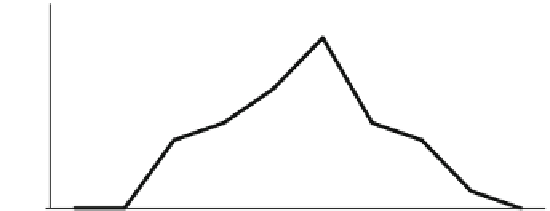Information Technology Reference
In-Depth Information
sometimes contrary—ways to progress a story; but, nevertheless, all of them make
sense. Notice that if different Previous Stories generate the same context, the system
only generates one Contextual-Structure and associates all possible next actions to
it. So, one Contextual-Structure might include several possible next actions to be
performed.
In the same way, if the Previous Stories are alike and therefore generate similar
Story-Contexts, the knowledge base will include similar Contextual-Structures, each
one with its own set of possible next actions to be performed. That is, the system
registers multiple options to progress the story under related circumstances. This
characteristic is exploited during plot generation.
The content of the Previous Stories determines what a “logical next action to
perform” is. For instance, if in the Previous Stories characters respond to other
characters in an aggressive way when they are in a bad mood, MEXICA records that
being aggressive is a logical action to perform when someone is irritable. In this way,
Previous Stories encode cultural characteristics that influence the development of new
plots. Thus, Contextual-Structures represent cultural common-sense knowledge.
In this way, the Abstract Representation establishes the universe of all possible
events that MEXICA can retrieve from memory during engagement.
The Tensional Representation is employed to document the dramatic tension in
the tale: when conflicts arise the tension grows; when conflicts are sorted out the
tensions decrease. In MEXICA all tensions have associated a numeric value; each
time an action is performed the system registers the value of all active tensions. In this
way, it is possible to obtain a graphic (see Fig.
13.1
). MEXICA classifies a narrative
as interesting when it includes increments and decrements of tensions. Thus, a story
is recounted in a correct manner when it follows the classical Aristotelian structure
of a story: development, climax and resolution (see Clayton [
8
] , p.p. 13-15) (see
Fig.
13.1
). Tensions play several important roles in MEXICA. The Tensional Repre-
sentations of the Previous Stories are employed as guidelines during plot generation.
In this way, the system knows when to incorporate new conflicts and when to work
them out. Finally, as it will be explained later, tensions are also employed during the
evaluation of a finished plot.
12
Climax
10
8
6
Development
Resolution
4
2
0
1
2
3
4
5
6
7
8
9
10
Actions
Fig. 13.1
A graphic of the dramatic tension in a story (Tensional Representation)























Search WWH ::

Custom Search